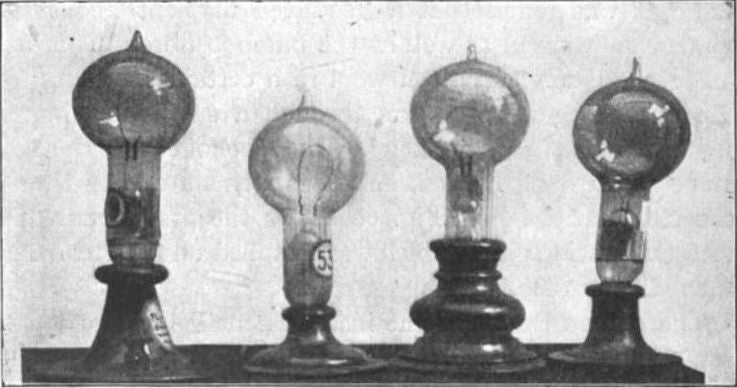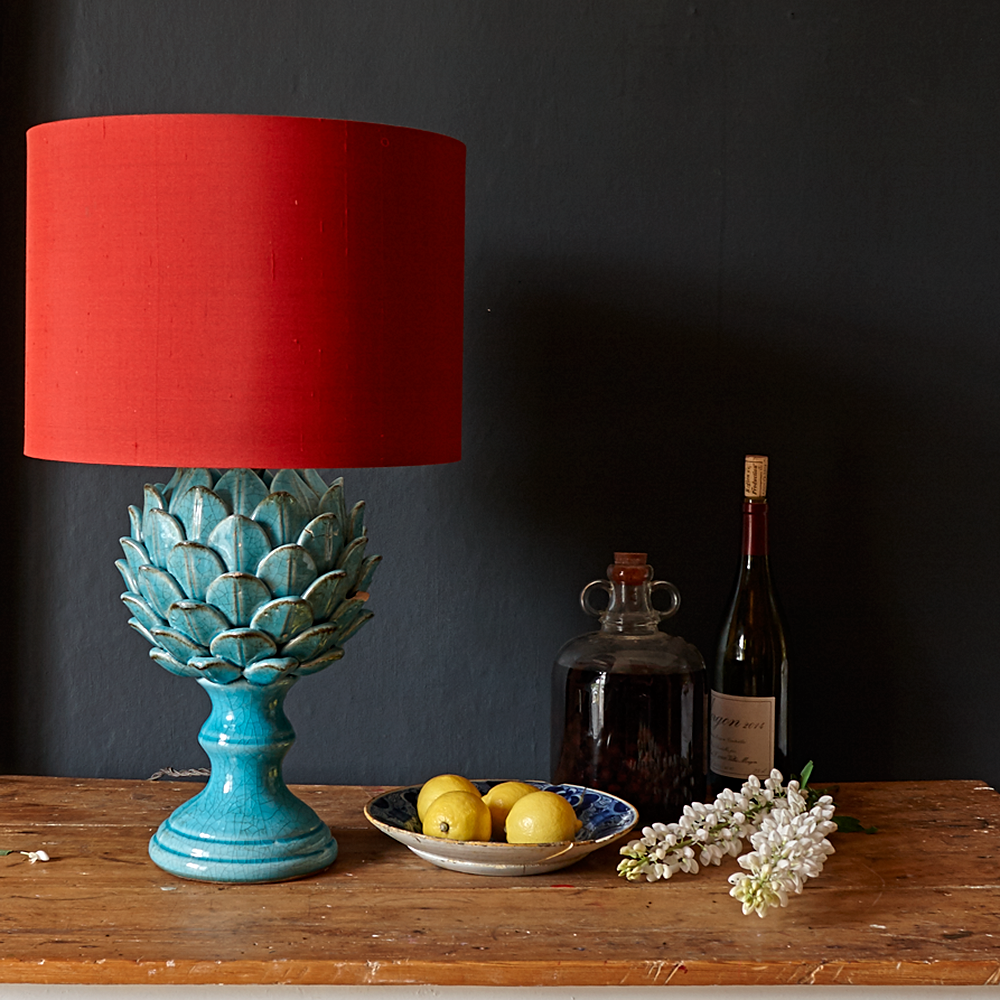
From the birth of art nouveau all the way through to postmodernism, our new blog series shows how the humble domestic table lamp holds the secret to understanding the entire history of design….
Did you know that you can discover virtually everything you need to know about the history of design just by looking very carefully at your nearest table lamp? We tend to take for granted the appliances we have in our homes, in all their varied shapes and sizes and styles. But the way our stuff looks now, in the 21st century, is the result of many decades of developments in science, art and cultural thinking. Contemporary designs only really make sense in the context of all the designs that came before.

Contemporary table lamps like the Shilton or Holly are influenced by decades of design concepts.
What’s more, looking at the table lamps of the past is a perfect way to understand each of the major international design movements. After all, the table lamp is a perfect medium for a designer: it has a specific practical purpose and is useful to literally everyone. Yet is very flexible about how it fulfils that purpose – it can be made from a wide variety of materials and take all kinds of shapes. This series of blog posts takes us from the invention of the light bulb all the way to postmodernism, via early art nouveau masterpieces, modernism, art deco, pop art and more. But first…
...What is design anyway?
Sitting somewhere between art and craftsmanship, ‘design’ is not an easy thing to define. Human beings have been making useful, attractive objects since time immemorial - including lighting. Simple stone oil lamps emerged in the Neolithic era, and by the 7th century BC the Ancient Greeks were making elaborate decorative terracotta versions, with ornamentation extending far beyond the lamp's practical purpose.
Ancient Roman Terracotta oil lamp decorated with a stylised cockerel, from the 4th century AD. Image credit.
But even though we often must delve deep into the past to understand particular design movements, most histories of ‘design’ as a concept in itself start relatively recently, with the emergence of mechanised industry.
The birth of design
The industrial revolution began in Britain and spread around the world in the late 18th and early 19th century. Before it, the person who conceived a product and the person who physically made it were usually one and the same. Whether a terracotta oil lamp, a simple Shaker chair or an intricate Swiss watch, the item was drafted and finished by a craftsman. But the shift from hand production methods to the machine-based factory system severed the link between the ‘planner’ of a product and the actual maker of it. This increasing division of labour led to the need for a new profession: the specialist industrial designer, whose job was to draft products that could be made efficiently by machines in mass quantities.The first design movements
In the middle of the 19th century industrial mass production was supplying goods to a western European middle class – or bourgeoisie – whose taste was formed by a Protestant ethic. They favoured unpretentious patterns and readymade wooden cabinets and chairs that could be bought 'off-the-shelf' but fitted together in harmonious arrangements because of their simplicity. During this time the business of ‘design’ was largely that of making things as simple as possible for machines to make. But as the century wore on, advances in technology meant that ever more complex items could be produced cheaply by machine tools. A fashion for very ornate decoration emerged – and soon there was barely a mirror or a chair in a Victorian middle-class home that wasn’t covered in neo-Baroque or neo-Gothic decorations.
The Drawing Room at 18 Stafford Terrace, a Victorian time capsule and a typical mish-mash of historicist styles. The Victorians didn't really do minimalism. Image © Kevin Moran Photography.
This period of ‘historicism’ in design mixed elements from all sorts of previous periods, from the Classical to the Renaissance to Romanticism in a great stylistic mish-mash. So we can see that design is therefore inextricably linked with scientific and technological innovation – and no scientific development has been more important than that of electric light…
Let there be light!
Oil, rush lights and candles remained the only ways for humans to escape the tyranny of darkness until coal gas began to be used in the 1790s. Very soon after, in 1810, the Cornishman Humphry Davy demonstrated to the Royal Society the first electric carbon ‘arc lighting’ system. Numerous scientists worked on improving his invention, but none solved the principal problem that arc light is far too blindingly bright to have in your home.
Early experimental carbon arc light powered by a battery of liquid cells. Arc lighting involved placing two carbon rods very close together so that an electric current sparked across the gap in an arc of vapour while the rods produced a white hot dazzling light. Arc lights are still used for floodlights to this day.
The quantum leap for domestic lighting came in 1878, with the invention of the commercially viable incandescent light bulb by (almost simultaneously but separately) the Englishman Joseph Swan and the American Thomas Edison
Early incandescent electric light bulbs invented by Thomas Edison in 1879. Incandescent electric light involves passing an electric current through a glowing wire filament inside an airless glass bulb. Neither Edison nor Swan originated the concept but they were first to develop a product that could be mass produced.
As early as 1879 commercial production of incandescent light bulbs began (already complete with the two main methods of attaching the bulbs to an electrical source – with Edison favouring the screw fitting and Swan the bayonet) and the two men combined to form the Edison & Swan United Lamp Company in 1880. Their importance in transforming the way we (literally) see the world cannot be overstated. Edison’s commercial drive matched his inventive genius: he invested his own wealth in building electricity plants and creating all the dynamos, junction boxes and sockets needed to bring his electric light into people’s houses. And he did so just at the time when industrial design was starting to get very interesting...
The great reform movements
Most design movements are reactions against previous movements – and this has been the case from the very earliest days of industrial design. At the end of the 19th century social and cultural reform movements kicked back against both mass industry and the backward-looking, derivative fashions of Victorian historicism. In England William Morris led the Arts & Crafts movement, which preferred handcrafts and simpler, organic forms derived directly from nature.
Hammered copper table lamp (c.1911) by the Arts & Crafts-inspired American designer Dirk van Erp. Image credit.
And on the continent, a similar but more industry-friendly aesthetic emerged. It lasted from around 1895 until the start of the First World War in 1914 and was arguably the first proper, distinctive internationalist design movement of the industrial age. It derived its fluid, organic patterns from nature: flower stems, wavy lines and asymmetrical shapes. In Britain they called it ‘the decorative style’, in Germany the Jugendstil (youth style) and in Italy the ‘Stile Liberty’ after, funnily enough, the London design house Liberty. However, it was the French name that finally caught on everywhere: art nouveau.
Art nouveau lighting
Art nouveau styles appeared on commercial, mass-produced products from furniture to prints to glassware. And of course, table lamps... In Nuremberg Germany, the Osiris factory of Freidrich and Walter Scherf developed a new form of metal alloy called ‘Isis’, which was perfect for moulding the organic shapes of their lamps…
Lamp, Osiris series by Friedrich Adler (Designer, attributed), Walter Scherf & Co. (Manufacturer), circa 1900-06. Image credit.
The French town of Nancy was a veritable hotbed of art nouveau invention. The artist Émile Gallé created exquisite, world-famous glass pieces based on plants, flowers and even fungi. But he also built a factory for mass manufactured goods – a perfect example of how ‘design’ straddles the art and industrial worlds.
Lampe aux Ombelles ('Umbels lamp') c. 1902, by Émile Gallé. Image credit.
Yet perhaps the most famous of all art nouveau designers wasn’t in Europe at all. The New Yorker Louis Comfort Tiffany took glass design to new levels of artistry – and created a series of legendary glass table lights, including the Lily, the Wisteria
Pond Lily Lamp, Tiffany Studios, Louis Comfort Tiffany designer, c. 1906-1910. Image credit.
The Pink Lotus lamp. Image credit.
Where art meets science
Of course, none of these beautiful lamps would have been possible without the very recent invention of incandescent light. It’s remarkable to think that within just a few years of Thomas Edison launching his light bulb in the 1880s, designers had seen the opportunities for wildly expressive designs and were creating commercially-available table lamps of exquisite sophistication and complexity. There really is no better illustration of how design represents the meeting point of art, craftsmanship and science than an art nouveau table lamp. However, every movement has a reaction, and even as art nouveau was at its peak, a very different aesthetic was starting to emerge. The birth of modernism features in part 2 of our history of design, and, naturally, table lamps show the way...
Pooky's art nouveau-inspired Artur in turquoise crackle glaze
The History of Design in Table Lamps series: Part 1: Thomas Edison to Art Nouveau Part 2: The Birth of Modernism Part 3: Art Deco Part 4: Mid-century Modernism Part 5: Pop and Postmodernism




















